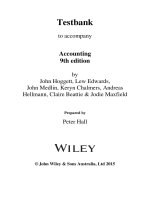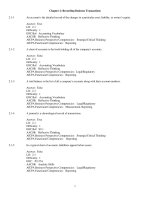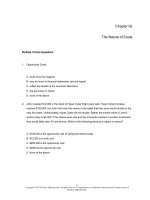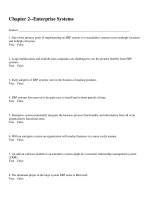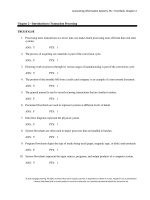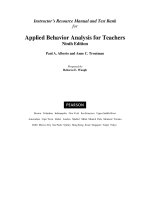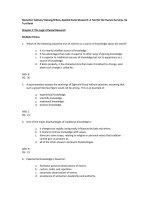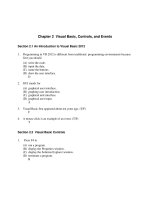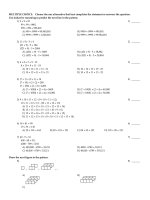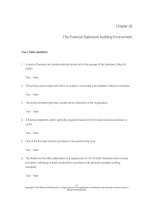Biopsychology 9th edition pinel test bank
Bạn đang xem bản rút gọn của tài liệu. Xem và tải ngay bản đầy đủ của tài liệu tại đây (402.24 KB, 34 trang )
CHAPTER 2
EVOLUTION, GENETICS, AND EXPERIENCE: THINKING ABOUT THE BIOLOGY OF BEHAVIOR
MULTIPLE CHOICE QUESTIONS
1) The general intellectual climate of a culture is referred to as its
A) canon.
B) guano.
C) Zeitgeist.
D) converging operations.
E) confounds.
Answer: C
Diff: 1 Page Ref: 21
Topic: Chapter 2 Introduction
Type: (Factual)
2) A major purpose of Chapter 2 of Biopsychology is to teach you not to think about the biology of
behavior in terms of
A) instinct.
B) Cartesian dualism.
C) traditional dichotomies.
D) psychology.
E) the brain.
Answer: C
Diff: 2 Page Ref: 21
Topic: 2.1 Thinking about the Biology of Behavior
Type: (Factual)
3) The idea that the human brain and human mind are separate entities was formalized in the 1600s by
A) Hebb.
B) Locke.
C) Plato.
D) Descartes.
E) Pinel.
Answer: D
Diff: 2 Page Ref: 21-22
Topic: 2.1 Thinking about the Biology of Behavior
Type: (Factual)
4) Descartes’s philosophy was called
A) monism.
B) behaviorism.
C) ethology.
D) mentalism.
E) dualism.
Answer: E
Diff: 2 Page Ref: 22
Copyright © 2014 Pearson Education, Inc. All rights reserved.
Test Bank for Biopsychology, 9/e
Topic: 2.1 Thinking about the Biology of Behavior
Type: (Factual)
5) Nature is to nurture as
A) learning is to genetics.
B) behaviorism is to ethology.
C) genetics is to experience.
D) both A and B
E) both B and C
Answer: C
Diff: 3 Page Ref: 22
Topic: 2.1 Thinking about the Biology of Behavior
Type: (Factual)
6) European ethologists focused on the study of
A) invertebrates.
B) instinctive behaviors.
C) learning.
D) both A and C
E) both B and C
Answer: B
Diff: 3 Page Ref: 22
Topic: 2.1 Thinking about the Biology of Behavior
Type: (Factual)
7) Asomatognosia is a
A) form of Korsakoff’s syndrome.
B) dualistic philosophy.
C) learned response.
D) consequence of hypothalamic damage.
E) deficiency in the awareness of parts of one’s own body.
Answer: E
Diff: 1 Page Ref: 22
Topic: 2.1 Thinking about the Biology of Behavior
Type: (Factual)
8) Asomatognosia typically
A) results from damage to the right parietal lobe.
B) affects the left side of the body.
C) affects both sides of the body.
D) affects the right side of the body.
E) both A and B
Answer: E
Diff: 3 Page Ref: 22
Topic: 2.1 Thinking about the Biology of Behavior
Type: (Factual)
Copyright © 2014 Pearson Education, Inc. All rights reserved.
2
Chapter 2: Evolution, Genetics, and Experience
9) Depicted here is the cortex of the right
A) parietal lobe.
B) hippocampus.
C) striatum.
D) frontal lobe.
E) prefrontal lobe.
Answer: A
Diff: 1 Page Ref: 23
Topic: 2.1 Thinking about the Biology of Behavior
Type: (Factual)
10) One way to study self-awareness in nonhuman animals is to confront them with
A) a mirror.
B) a photograph of themselves.
C) an experiment.
D) a frontal-lobe lesion.
E) a difficult task.
Answer: A
Diff: 1 Page Ref: 23
Topic: 2.1 Thinking about the Biology of Behavior
Type: (Factual)
11) According to the text, the phrase, “Reports of its death have been greatly exaggerated.” sums up the
history of
A) biopsychology.
B) physiology.
C) Cartesian dualism.
D) nature-or-nurture thinking.
E) comparative psychology.
Answer: D
Diff: 3 Page Ref: 24
Topic: 2.1 Thinking about the Biology of Behavior
Type: (Factual)
12) All behavior is the product of
A) an organism’s genetic endowment.
B) an organism’s experience.
C) an organism’s perception of the current situation.
D) all of the above
E) both A and B
Answer: D
Diff: 3 Page Ref: 24
Topic: 2.1 Thinking about the Biology of Behavior
Type: (Conceptual)
Rationale: The answer is reinforced by Figure 2.3.
Copyright © 2014 Pearson Education, Inc. All rights reserved.
3
Test Bank for Biopsychology, 9/e
13) The single most influential theory in the biological sciences is the theory of
A) D. O. Hebb.
B) Charles Darwin.
C) evolution.
D) both A and C
E) both B and C
Answer: E
Diff: 2 Page Ref: 24
Topic: 2.2 Human Evolution
Type: (Factual)
14) Darwin’s theory of evolution was published in
A) 1312.
B) 1562.
C) 1859.
D) 1920.
E) 1943.
Answer: C
Diff: 2 Page Ref: 24
Topic: 2.2 Human Evolution
Type: (Factual)
Rationale: This seems to be an extremely specific question, but because the incorrect options are so
grossly incorrect, students need to have only a general idea of the timing to answer correctly.
15) Darwin was not the first to suggest that species evolve, but he was the first to suggest that
A) evolution occurs through natural selection.
B) cultures rarely evolve.
C) evolution occurs by genetics.
D) mammals do not evolve.
E) sex is an important component of evolution for all living species.
Answer: A
Diff: 2 Page Ref: 25
Topic: 2.2 Human Evolution
Type: (Factual)
16) Darwin suggested a mechanism for evolution:
A) genes.
B) natural selection.
C) sex.
D) all of the above
E) none of the above
Answer: B
Diff: 2 Page Ref: 25
Topic: 2.2 Human Evolution
Type: (Factual)
Copyright © 2014 Pearson Education, Inc. All rights reserved.
4
Chapter 2: Evolution, Genetics, and Experience
17) Horse breeders have created faster horses through programs of
A) natural selection.
B) gene splicing.
C) selective breeding.
D) domestication.
E) euthanasia.
Answer: C
Diff: 1 Page Ref: 25
Topic: 2.2 Human Evolution
Type: (Factual)
18) Fitness in the Darwinian sense refers to an organism’s ability to
A) survive and contribute large numbers of fertile offspring to the next generation.
B) remain healthy.
C) win fights.
D) survive.
E) avoid predation.
Answer: A
Diff: 2 Page Ref: 25
Topic: 2.2 Human Evolution
Type: (Factual)
19) Social dominance is an important factor in evolution because dominant males often
A) kill their mates.
B) become seriously injured.
C) produce more offspring than nondominant males.
D) establish hierarchies.
E) are much larger.
Answer: C
Diff: 2 Page Ref: 26
Topic: 2.2 Human Evolution
Type: (Factual)
20) Courtship displays are important evolutionary phenomena because they
A) promote the evolution of new species.
B) promote extinction.
C) facilitate aggression.
D) encourage social dominance.
E) eliminate copulation.
Answer: A
Diff: 2 Page Ref: 27
Topic: 2.2 Human Evolution
Type: (Factual)
Copyright © 2014 Pearson Education, Inc. All rights reserved.
5
Test Bank for Biopsychology, 9/e
21) The conspecific of a vole is a
A) rat.
B) monkey.
C) human.
D) mouse.
E) vole.
Answer: E
Diff: 2 Page Ref: 27
Topic: 2.2 Human Evolution
Type: (Factual)
22) Evidence suggests that complex multicellular, water-dwelling organisms first appeared on earth
A) in the early 1920s.
B) 600 million years ago.
C) 10 million years ago.
D) 4 million years ago.
E) 2 million years ago.
Answer: B
Diff: 2 Page Ref: 27
Topic: 2.2 Human Evolution
Type: (Factual)
Rationale: This has the appearance of a very specific question, but the student requires only a general
concept of the timing to answer correctly.
23) Animals with dorsal nerve cords are called
A) phyla.
B) chordates.
C) vertebrates.
D) mammals.
E) amphibians.
Answer: B
Diff: 2 Page Ref: 27
Topic: 2.2 Human Evolution
Type: (Factual)
24) Which of the following are chordates?
A) humans
B) vertebrates
C) Florida walking catfish
D) mammals
E) all of the above
Answer: E
Diff: 2 Page Ref: 27
Topic: 2.2 Human Evolution
Type: (Conceptual)
Rationale: Any animal with a dorsal nerve cord is a chordate.
Copyright © 2014 Pearson Education, Inc. All rights reserved.
6
Chapter 2: Evolution, Genetics, and Experience
25) Which of the following is not true?
A) All mammals are chordates.
B) All chordates are vertebrates.
C) All reptiles are vertebrates.
D) All mammals are vertebrates.
E) All vertebrates are chordates.
Answer: B
Diff: 3 Page Ref: 27
Topic: 2.2 Human Evolution
Type: (Conceptual)
Rationale: To choose the correct answer, students must understand that some animals have dorsal nerve
cords without having spines.
26) Birds and reptiles are
A) amphibians.
B) chordates.
C) vertebrates.
D) all of the above
E) both B and C
Answer: E
Diff: 3 Page Ref: 27
Topic: 2.2 Human Evolution
Type: (Conceptual)
Rationale: To choose the correct answer, students must understand that birds and reptiles have both
spines and dorsal nerve cords and that they are not amphibians.
27) The first animals to start to venture out of the water were
A) reptiles.
B) bony fishes.
C) amphibians.
D) Florida walking catfish.
E) both B and C
Answer: B
Diff: 3 Page Ref: 28
Topic: 2.2 Human Evolution
Type: (Factual)
28) Frogs, toads, and salamanders are
A) vertebrates.
B) chordates.
C) amphibians.
D) all of the above
E) both A and C
Answer: D
Diff: 3 Page Ref: 27
Topic: 2.2 Human Evolution
Type: (Factual)
Copyright © 2014 Pearson Education, Inc. All rights reserved.
7
Test Bank for Biopsychology, 9/e
29) Lizards, snakes, and turtles are
A) reptiles.
B) amphibians.
C) vertebrates.
D) both A and C
E) both B and C
Answer: D
Diff: 2 Page Ref: 28
Topic: 2.2 Human Evolution
Type: (Factual)
Rationale: The key to answering this question correctly is to understand that lizards, snakes, and turtles
are not amphibians.
30) Reptiles evolved directly from
A) amphibians.
B) fish.
C) bony fish.
D) prosimians.
E) snakes.
Answer: A
Diff: 2 Page Ref: 28
Topic: 2.2 Human Evolution
Type: (Factual)
31) Reptiles were the first animals to
A) have back bones.
B) lay shell-covered eggs.
C) be covered by dry scales.
D) both A and B
E) both B and C
Answer: E
Diff: 3 Page Ref: 28
Topic: 2.2 Human Evolution
Type: (Factual)
32) Mammals evolved directly from
A) reptiles.
B) fish.
C) amphibians.
D) prosimians.
E) primates.
Answer: A
Diff: 2 Page Ref: 28
Topic: 2.2 Human Evolution
Type: (Factual)
Copyright © 2014 Pearson Education, Inc. All rights reserved.
8
Chapter 2: Evolution, Genetics, and Experience
33) One remaining mammalian species that lays eggs is the
A) duck-billed platypus.
B) hominin.
C) prosimian.
D) Florida walking catfish.
E) orangutan.
Answer: A
Diff: 2 Page Ref: 28
Topic: 2.2 Human Evolution
Type: (Factual)
Rationale: This appears to be a difficult question, but it should be relatively easy for alert students to rule
out the incorrect options.
34) Prosimians, hominins, and apes are all
A) old-world monkeys.
B) new-world monkeys.
C) langurs.
D) primates.
E) both B and C
Answer: D
Diff: 3 Page Ref: 28
Topic: 2.2 Human Evolution
Type: (Factual)
35) Unlike Old-World monkeys, apes
A) do not have tails.
B) have opposable thumbs that are not useful for precise manipulation.
C) do not have opposable thumbs.
D) cannot walk upright for short distances.
E) have tails.
Answer: A
Diff: 3 Page Ref: 28
Topic: 2.2 Human Evolution
Type: (Factual)
36) According to the simplest theory, the hominin line is composed of two different genera:
A) Australopithecus and Homo.
B) apes and Homo sapiens.
C) apes and humans.
D) old-world monkeys and new-world monkeys.
E) reptiles and amphibians.
Answer: A
Diff: 3 Page Ref: 29
Topic: 2.2 Human Evolution
Type: (Factual)
Copyright © 2014 Pearson Education, Inc. All rights reserved.
9
Test Bank for Biopsychology, 9/e
37) The first hominins are thought to have evolved about
A) 200 million years ago.
B) 100 million years ago.
C) 50 million years ago.
D) 6 million years ago.
E) 1 million years ago.
Answer: D
Diff: 3 Page Ref: 28
Topic: 2.2 Human Evolution
Type: (Factual)
38) Australopithecines, the first hominins, are thought to have evolved about __________ years ago.
A) 100 million
B) 150 million
C) 90 million
D) 6 million
E) 100 thousand
Answer: D
Diff: 2 Page Ref: 28
Topic: 2.2 Human Evolution
Type: (Factual)
39) Australo means __________; pithecus means __________.
A) African; gorilla
B) southern; ape
C) African; chimpanzee
D) African; ape
E) African; man
Answer: B
Diff: 3 Page Ref: 29
Topic: 2.2 Human Evolution
Type: (Factual)
40) Well preserved 3.6-million-year-old footprints of 1.3-meter tall, small-brained __________ were
discovered in African volcanic ash.
A) apes
B) Homo sapiens
C) Neanderthals
D) Australopithecines
E) archaeologists
Answer: D
Diff: 2 Page Ref: 30
Topic: 2.2 Human Evolution
Type: (Factual)
Copyright © 2014 Pearson Education, Inc. All rights reserved.
10
Chapter 2: Evolution, Genetics, and Experience
41) About 200 thousand years ago, early hominins were gradually replaced in the African fossil record
by
A) old-world monkeys.
B) accountants.
C) modern humans.
D) primates.
E) Australopithecus.
Answer: C
Diff: 2 Page Ref: 30
Topic: 2.2 Human Evolution
Type: (Factual)
42) Metaphorically, evolution is a
A) scale.
B) ladder.
C) book.
D) bush.
E) soap dish.
Answer: D
Diff: 1 Page Ref: 30
Topic: 2.2 Human Evolution
Type: (Conceptual)
Rationale: Most students will enter the course thinking of evolution as a ladder; this question tests
whether they have managed to modify their thinking.
43) The last surviving hominin species is
A) Australopithecus.
B) Homo sapiens.
C) prosimians.
D) lemurs.
E) tree shrews.
Answer: B
Diff: 1 Page Ref: 30
Topic: 2.2 Human Evolution
Type: (Factual)
44) Sudden evolutionary changes are often triggered by
A) selective breeding.
B) fossilization.
C) paleontologists.
D) brains.
E) sudden changes in the environment.
Answer: E
Diff: 1 Page Ref: 29
Topic: 2.2 Human Evolution
Type: (Factual)
Rationale: In this question, the incorrect options are obvious.
Copyright © 2014 Pearson Education, Inc. All rights reserved.
11
Test Bank for Biopsychology, 9/e
45) Scientists who study fossils are called
A) archaeologists.
B) evolutionists.
C) podiatrists.
D) geologists.
E) paleontologists.
Answer: E
Diff: 2 Page Ref: 30
Topic: 2.2 Human Evolution
Type: (Factual)
46) Approximately what proportion of all species that ever existed on earth are still in existence?
A) about 61%
B) about 31%
C) about 7.5%
D) less than 1%
E) about 19%
Answer: D
Diff: 2 Page Ref: 30
Topic: 2.2 Human Evolution
Type: (Factual)
Rationale: This specific question is relatively easy because the incorrect options are grossly incorrect.
47) Which of the following are evolutionary changes that are not adaptive?
A) spandrels
B) exaptations
C) homologous structures
D) analogous structures
E) both B and C
Answer: A
Diff: 3 Page Ref: 31
Topic: 2.2 Human Evolution
Type: (Conceptual)
Rationale: To answer this question correctly, students must have a good knowledge of the four concepts
that comprise the list of options. Spandrels are incidental nonadaptive evolutionary by-products.
48) Which of the following characteristics evolved to perform one function and were then co-opted to
perform another?
A) exaptations
B) spandrels
C) homologues
D) analogues
E) none of the above
Answer: A
Diff: 2 Page Ref: 31
Topic: 2.2 Human Evolution
Type: (Conceptual)
Rationale: This is an important concept because it means that the current function of an evolved
characteristic does not necessarily indicate why it originally evolved.
Copyright © 2014 Pearson Education, Inc. All rights reserved.
12
Chapter 2: Evolution, Genetics, and Experience
49) Convergent evolution produces structures that are
A) convergent.
B) analogous.
C) homologous.
D) both A and C
E) both B and C
Answer: B
Diff: 3 Page Ref: 31
Topic: 2.2 Human Evolution
Type: (Conceptual)
Rationale: Convergent evolution is the evolution of similar structures from unrelated species--such
similar but unrelated structures are said to be analogous.
50) A bird’s wing and a bee’s wing are
A) convolutions.
B) cerebral.
C) convergent.
D) homologous.
E) analogous.
Answer: E
Diff: 2 Page Ref: 31
Topic: 2.2 Human Evolution
Type: (Conceptual)
Rationale: Similar structures evolved from unrelated species are termed analogous.
51) Early research on the evolution of the brain focused on
A) its size.
B) the brain stem.
C) the thalamus.
D) the uvula.
E) its chemistry.
Answer: A
Diff: 1 Page Ref: 32
Topic: 2.2 Human Evolution
Type: (Factual)
52) Which species has a brain larger than the human brain?
A) whale
B) elephant
C) chimpanzee
D) all of the above
E) both A and B
Answer: E
Diff: 2 Page Ref: 32
Topic: 2.2 Human Evolution
Type: (Factual)
Copyright © 2014 Pearson Education, Inc. All rights reserved.
13
Test Bank for Biopsychology, 9/e
53) Modern adult human brains vary in size from about
A) 1,000 to 2,000 grams.
B) 10 to 20 grams.
C) 1,440 to 1,500 grams.
D) 1,300 to 1,400 grams.
E) 1,350 to 1,360 grams.
Answer: A
Diff: 3 Page Ref: 32
Topic: 2.2 Human Evolution
Type: (Factual)
Rationale: If students remember that there is a lot of variability in human brain size, they should be able
to answer this seemingly specific question.
54) In terms of which of the following measures of brain size are humans surpassed by shrews?
A) brain weight
B) brain volume
C) neocortex volume
D) cerebellum volume
E) brain weight expressed as a percentage of total body weight
Answer: E
Diff: 2 Page Ref: 32
Topic: 2.2 Human Evolution
Type: (Factual)
55) In general, the brain stem regulates
A) thinking.
B) memory.
C) emotion.
D) reflex activities critical for survival.
E) vision.
Answer: D
Diff: 1 Page Ref: 32
Topic: 2.2 Human Evolution
Type: (Factual)
56) During the course of human evolution, there has been a general increase in the
A) size of the brain.
B) number of cortical convolutions.
C) size of the cortex.
D) size of the cerebrum.
E) all of the above
Answer: E
Diff: 1 Page Ref: 33
Topic: 2.2 Human Evolution
Type: (Factual)
Copyright © 2014 Pearson Education, Inc. All rights reserved.
14
Chapter 2: Evolution, Genetics, and Experience
57) The field that focuses on the evolution of human behavior is
A) the human genome.
B) humanism.
C) evolutionary psychology.
D) behavioral evolution.
E) human genetics.
Answer: C
Diff: 2 Page Ref: 33
Topic: 2.2 Human Evolution
Type: (Factual)
57) In most vertebrate species, mating is
A) monogamous.
B) promiscuous.
C) polygynous.
D) polyandrous.
E) asexual.
Answer: B
Diff: 2 Page Ref: 33
Topic: 2.2 Human Evolution
Type: (Factual)
59) The pattern of mate bonding that is most prevalent in mammals is
A) promiscuity.
B) polygyny.
C) monogamy.
D) polyandry.
E) marriage.
Answer: B
Diff: 2 Page Ref: 33
Topic: 2.2 Human Evolution
Type: (Factual)
60) According to one prominent theory, monogamy evolved in only those species
A) in which each female could raise more fit young if she had undivided help.
B) with opposable thumbs.
C) with large brains.
D) that used tools.
E) all of the above
Answer: A
Diff: 2 Page Ref: 34
Topic: 2.2 Human Evolution
Type: (Factual)
Copyright © 2014 Pearson Education, Inc. All rights reserved.
15
Test Bank for Biopsychology, 9/e
61) Mendel
A) studied dichotomous pea-plant traits.
B) began his experiments by crossing the offspring of true-breeding lines.
C) collaborated with Darwin.
D) all of the above
E) both A and B
Answer: E
Diff: 3 Page Ref: 35
Topic: 2.3 Fundamental Genetics
Type: (Factual)
62) Mendel’s early experiments challenged the central premise upon which previous ideas about
inheritance had rested. This was the premise that
A) there is only one gene for each trait.
B) there are two genes for each trait.
C) offspring can inherit only those traits that are displayed by their parents.
D) white seeds are dominant.
E) some traits are dominant and some are recessive.
Answer: C
Diff: 2 Page Ref: 35
Topic: 2.3 Fundamental Genetics
Type: (Factual)
63) An organism’s observable traits are referred to as its
A) genotype.
B) phenotype.
C) dominant traits.
D) recessive traits.
E) none of the above
Answer: B
Diff: 2 Page Ref: 35
Topic: 2.3 Fundamental Genetics
Type: (Factual)
64) The two genes, one on each chromosome of a pair, that control the same trait are called
A) dominants.
B) phenotypes.
C) genotypes.
D) gametes.
E) alleles.
Answer: E
Diff: 2 Page Ref: 36
Topic: 2.3 Fundamental Genetics
Type: (Factual)
Copyright © 2014 Pearson Education, Inc. All rights reserved.
16
Chapter 2: Evolution, Genetics, and Experience
65) Individuals who possess two identical genes for a particular trait
A) are homozygous for that trait.
B) are heterozygous for that trait.
C) cannot have offspring of the same phenotype for that trait.
D) cannot have offspring of the same genotype for that trait.
E) none of the above
Answer: A
Diff: 2 Page Ref: 36
Topic: 2.3 Fundamental Genetics
Type: (Factual)
66) If an individual has a recessive phenotype for a particular trait, it can be concluded that
A) both parents also had a recessive phenotype for that trait.
B) only one parent had a recessive phenotype for that trait.
C) both parents were homozygous for the dominant gene for that trait.
D) each parent had at least one recessive gene for that trait.
E) both A and C
Answer: D
Diff: 3 Page Ref: 36
Topic: 2.3 Fundamental Genetics
Type: (Conceptual)
Rationale: To answer this question correctly, students need to understand the relation between the
concepts of phenotype and genotype. If a person has a recessive phenotype for a particular trait, they
must have two recessive genes for that trait, one from the mother and one from the father.
67) In each cell of the human body, there are normally
A) 21 chromosomes.
B) 21 pairs of chromosomes.
C) 23 genes.
D) 23 chromosomes.
E) 23 pairs of chromosomes.
Answer: E
Diff: 1 Page Ref: 36
Topic: 2.3 Fundamental Genetics
Type: (Factual)
68) Gametes are produced by
A) mitosis.
B) mitotic cell division.
C) meiosis.
D) copulation
E) fertilization.
Answer: C
Diff: 2 Page Ref: 36
Topic: 2.3 Fundamental Genetics
Type: (Factual)
Copyright © 2014 Pearson Education, Inc. All rights reserved.
17
Test Bank for Biopsychology, 9/e
69) Just prior to mitotic cell division, the number of chromosomes in the cell
A) doubles.
B) is reduced by half.
C) doubles twice.
D) stays the same.
E) is increased by 50%.
Answer: A
Diff: 2 Page Ref: 37
Topic: 2.3 Fundamental Genetics
Type: (Factual)
70) The “letters” of the genetic code are
A) deoxyribose bases.
B) phosphates.
C) nucleotide bases.
D) amino acids.
E) peptides.
Answer: C
Diff: 1 Page Ref: 37
Topic: 2.3 Fundamental Genetics
Type: (Factual)
71) How many different nucleotide bases are there in DNA?
A) l
B) 2
C) 4
D) 7
E) 26
Answer: C
Diff: 1 Page Ref: 36
Topic: 2.3 Fundamental Genetics
Type: (Factual)
72) On the DNA molecule, cytosine binds to
A) guanine.
B) adenine.
C) thymine.
D) thiamine.
E) uracil.
Answer: A
Diff: 2 Page Ref: 37
Topic: 2.3 Fundamental Genetics
Type: (Factual)
Copyright © 2014 Pearson Education, Inc. All rights reserved.
18
Chapter 2: Evolution, Genetics, and Experience
73) In Down syndrome, there is
A) no guanine.
B) no adenine.
C) no thymine.
D) no cytosine.
E) an extra chromosome in each cell.
Answer: E
Diff: 2 Page Ref: 37-38
Topic: 2.3 Fundamental Genetics
Type: ( Applied)
74) Accidental alteration in individual genes during replication is called
A) crossing over.
B) translation.
C) linkage.
D) mutation.
E) self-duplication.
Answer: D
Diff: 2 Page Ref: 38
Topic: 2.3 Fundamental Genetic
Type: (Factual)
75) Illustrated here is
A) mitosis.
B) meiosis.
C) the replication of a DNA molecule.
D) the replication of an RNA molecule.
E) an enhancer.
Answer: C
Diff: 2 Page Ref: 38
Topic: 2.3 Fundamental Genetics
Type: (Factual)
76) Female mammals have
A) only one X chromosome.
B) only one Y chromosome.
C) two X chromosomes.
D) two Y chromosomes.
E) both A and B
Answer: C
Diff: 1 Page Ref: 38
Topic: 2.3 Fundamental Genetics
Type: (Factual)
Copyright © 2014 Pearson Education, Inc. All rights reserved.
19
Test Bank for Biopsychology, 9/e
77) Color blindness occurs more frequently in males than in females because it is
A) dominant.
B) rare.
C) quite common.
D) a recessive sex-linked trait.
E) both A and B
Answer: D
Diff: 3 Page Ref: 38
Topic: 2.3 Fundamental Genetics
Type: (Applied)
78) Sex-linked traits that are controlled by dominant genes occur more frequently in
A) females.
B) males.
C) neural disorders.
D) XY individuals.
E) both B and D
Answer: A
Diff: 3 Page Ref: 38
Topic: 2.3 Fundamental Genetics
Type: (Factual)
Rationale: This is so because most sex-linked traits are controlled by genes on the X chromosome and
females have twice as many X chromosomes.
79) Which of the following is a short segment of DNA that determines the rate at which a protein will be
synthesized by a particular structural gene?
A) ribosome
B) enhancer
C) codon
D) nucleotide
E) codon segment
Answer: B
Diff: 2 Page Ref: 38
Topic: 2.3 Fundamental Genetics
Type: (Factual)
80) Proteins that bind to DNA and influence the rate at which particular structural genes will be
expressed are called
A) transcription factors.
B) autosomes.
C) enhancers.
D) sex-linked traits.
E) mutations.
Answer: A
Diff: 1 Page Ref: 39
Topic: 2.3 Fundamental Genetics
Type: (Factual)
Copyright © 2014 Pearson Education, Inc. All rights reserved.
20
Chapter 2: Evolution, Genetics, and Experience
81) DNA is to RNA as
A) guanine is to uracil.
B) thymine is to cytosine.
C) uracil is to thymine.
D) thymine is to uracil.
E) uracil is to guanine.
Answer: D
Diff: 3 Page Ref: 40
Topic: 2.3 Fundamental Genetics
Type: (Conceptual)
Rationale: In order to answer this, students must understand that thymine molecules on strands of DNA
are substituted by uracil molecules on strands of RNA.
82) Each codon on a strand of messenger RNA
A) comprises three consecutive bases on the messenger RNA molecule.
B) instructs the ribosome to add one amino acid from the cytoplasm to the growing protein chain.
C) contains all of the information necessary to synthesize a complete protein.
D) both A and B
E) both A and C
Answer: D
Diff: 2 Page Ref: 40
Topic: 2.3 Fundamental Genetics
Type: (Factual)
83) During protein synthesis, each amino acid is carried to the ribosome by
A) a transfer RNA molecule.
B) a codon.
C) a messenger RNA molecule.
D) an operator gene.
E) a mitochondrion.
Answer: A
Diff: 2 Page Ref: 40
Topic: 2.3 Fundamental Genetics
Type: (Factual)
84) Mitochondria are
A) located in the nuclei of cells.
B) located in the cytoplasm of cells.
C) energy-generating structures of cells.
D) both A and C
E) both B and C
Answer: E
Diff: 3 Page Ref: 40
Topic: 2.3 Fundamental Genetics
Type: (Factual)
Copyright © 2014 Pearson Education, Inc. All rights reserved.
21
Test Bank for Biopsychology, 9/e
85) All mitochondrial genes are inherited only
A) if they have first undergone mutation.
B) from one’s mother.
C) from one’s father.
D) from one’s siblings.
E) if they have first been transcribed.
Answer: B
Diff: 2 Page Ref: 40
Topic: 2.3 Fundamental Genetics
Type: (Factual)
86) Arguably, the most ambitious scientific project of all time began in 1990: the
A) American space program.
B) cognitive neuroscience project.
C) human genome project.
D) decade of the brain.
E) theory of evolution.
Answer: C
Diff: 1 Page Ref: 41
Topic: 2.3 Fundamental Genetics
Type: (Factual)
87) Construction of a detailed physical map of human chromosomes
A) began in earnest in 1960.
B) was completed by entirely by American scientists.
C) was completed in 1990.
D) was an attempt to locate all 3 billion human chromosomes.
E) none of the above
Answer: E
Diff: 3 Page Ref: 40
Topic: 2.3 Fundamental Genetics
Type: (Factual)
Rationale: None of these statements is correct; D is incorrect because human DNA contains 3 billion
bases, not 3 billion chromosomes.
88) The most surprising finding of the human genome project is that humans have
A) 7-base codons.
B) many mutations.
C) relatively few protein-coding genes.
D) so many genes.
E) more genes than corn has.
Answer: C
Diff: 2 Page Ref: 41
Topic: 2.3 Fundamental Genetics
Type: (Factual)
Copyright © 2014 Pearson Education, Inc. All rights reserved.
22
Chapter 2: Evolution, Genetics, and Experience
89) How many structural (protein-coding) genes are there in the human genome?
A) about 20,000
B) 1,000 times more than in the corn genome.
C) 8 times more than in the mouse genome.
D) 38 times more than in the mouse genome.
E) about 3 billion.
Answer: A
Diff: 2 Page Ref: 41
Topic: 2.3 Fundamental Genetics
Type: (Factual)
90) The study of all mechanisms of inheritance other than the classic genetic code and its expression is
called
A) Mendelian genetics.
B) the human genome project.
C) pseudogenetics.
D) epigenetics.
E) none of the above
Answer: D
Diff: 3 Page Ref: 41
Topic: 2.3 Fundamental Genetics
Type: (Factual)
91) Epigenetic investigation, although of recent origin, has already identified
A) many active areas of nongene (junk) DNA.
B) various kinds of small RNA molecules.
C) histone remodeling as an important mechanism by which experience can influence gene expression.
D) DNA methylation as an important epigenetic mechanism.
E) all of the above
Answer: E
Diff: 3 Page Ref: 42
Topic: 2.3 Fundamental Genetics
Type: (Factual)
92) RNA editing is an important epigenetic mechanism: It occurs when small RNA molecules act directly
on strands of
A) messenger DNA.
B) junk DNA.
C) histone.
D) methylated DNA.
E) messenger RNA.
Answer: E
Diff: 2 Page Ref: 42
Topic: 2.4 Behavioral Development: Genetic Factors and Experience
Type: (Factual)
93) Tryon is famous for
Copyright © 2014 Pearson Education, Inc. All rights reserved.
23
Test Bank for Biopsychology, 9/e
A) twin studies of IQ.
B) selectively breeding so-called maze bright and maze dull strains of rats.
C) studies of genetic mutation.
D) research on bird song.
E) the discovery PKU.
Answer: B
Diff: 2 Page Ref: 43
Topic: 2.4 Behavioral Development: Genetic Factors and Experience
Type: (Factual)
94) Searle (1949) found that, in comparison to maze-dull rats, maze-bright rats were
A) not generally superior in learning ability.
B) less emotional.
C) more emotional.
D) both A and B
E) both A and C
Answer: D
Diff: 3 Page Ref: 44
Topic: 2.4 Behavioral Development: Genetic Factors and Experience
Type: (Factual)
95) Cooper and Zubek (1958) found that maze-bright rats made fewer maze errors than maze-dull rats
only if both groups had
A) been reared in an impoverished laboratory environment.
B) been reared in an enriched laboratory environment.
C) been equated for emotionality.
D) received tranquilizers.
E) been pretrained.
Answer: A
Diff: 3 Page Ref: 44
Topic: 2.4 Behavioral Development: Genetic Factors and Experience
Type: (Factual)
96) Which of the following disorders was discovered by Asbjörn Fölling, a Norwegian dentist?
A) schizophrenia
B) Korsakoff’s syndrome
C) phenylketonuria
D) Parkinsonism
E) Down syndrome
Answer: C
Diff: 2 Page Ref: 44
Topic: 2.4 Behavioral Development: Genetic Factors and Experience
Type: (Factual)
97) People with phenylketonuria have high levels of urinary
Copyright © 2014 Pearson Education, Inc. All rights reserved.
24
Chapter 2: Evolution, Genetics, and Experience
A) PKU.
B) phenylpyruvic acid.
C) phenylalanine hydroxylase.
D) tyrosine.
E) ontogeny
Answer: B
Diff: 3 Page Ref: 44
Topic: 2.4 Behavioral Development: Genetic Factors and Experience
Type: (Applied)
98) PKU is transmitted by a
A) recessive gene mutation.
B) pair of dominant genes.
C) dominant gene mutation.
D) triad of recessive genes.
E) single extra chromosome 23.
Answer: A
Diff: 2 Page Ref: 44
Topic: 2.4 Behavioral Development: Genetic Factors and Experience
Type: (Factual)
99) People with PKU lack the enzyme
A) that converts phenylalanine to tyrosine.
B) phenylpyruvic acid.
C) phenylalanine hydroxylase.
D) both A and B
E) both A and C
Answer: E
Diff: 3 Page Ref: 45
Topic: 2.4 Behavioral Development: Genetic Factors and Experience
Type: (Applied)
100) In many modern hospitals, the blood of newborn infants is routinely screened for high levels of
A) phenylalanine.
B) phenylpyruvic acid.
C) phenylalanine hydroxylase.
D) all of the above
E) both B and C
Answer: A
Diff: 3 Page Ref: 45
Topic: 2.4 Behavioral Development: Genetic Factors and Experience
Type: (Applied)
101) The sensitive period for the development of a particular trait is the period
Copyright © 2014 Pearson Education, Inc. All rights reserved.
25
